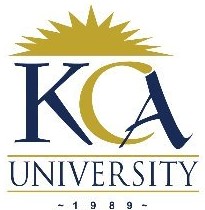 KCA UNIVERSITY
KCA UNIVERSITY
UNIVERSITY EXAMINATIONS 2017
SUPPLEMENTARY/SPECIAL EXAMINATIONS FOR STAGE II SEMESTER III BACHELOR
OF SCIENCE IN INFORMATION TECHNOLOGY
BIT 4302 TELECOMMUNICATIONS
SPECIAL /SUPPLEMENTARY EXAMINATION
DATE: JULY, 2017 TIME: 2 HOURS
DATE: AUGUST, 2017 TIME: 2 HRS
INSTRUCTIONS
Answer Question one and any other two questions.
1. a. State, with appropriate equations, Nyquist and Shannon’s Theorems. 6 Marks
b. Distinguish between “piconet” and “scatternet” as used in Bluetooth technology. 4 Marks
c. (i) Define the term convergence s used in Computer networks 1 Mark
(ii) Converged networks have existed for a while now, but were only feasible in large
enterprise organizations. Why? 4 Marks
(iii) Why is it difficulty for some organizations to make a decision to move towards
converged networks? 2 Marks
d. State five major differences between WLANs and wired Ethernet. 5 Marks
e. Teleworkers require a connection to an ISP to access the Internet. ISPs offer various
connection options. Describe the following main connection methods used by home and small
business users:
(i) DSL 2 Marks
(ii) Cable modem 2 Marks
(iii) Satellite 2 Marks
f. State any two major characteristics of WANs. 2 Marks
2. a. Describe the two levels of ISDN services (BRI and PRI). 7 Marks
b. Explain briefly four major criteria that a data communication network must meet.
4 Marks
c. Discuss briefly the importance of error detection and correction, flow control and recovery
in data communications. 5 Marks
3. a. With the aid of relevant diagrams, describe Very Small Aperture Terminals (and satellite)
communications. 9 Marks
b. WANs use numerous types of devices that are specific to WAN environments. Describe
any five of these devices 5 Marks
c. With any communications medium, the received signal will differ from the transmitted
signal due to various transmission impairments. Discuss any three of these impairments. 6 Marks
4. a. With the aid of a relevant diagram, describe the GSM Architecture 9 Marks
b. A routing protocol is a set of processes, algorithms, and messages that are used to
exchange routing information and populate the routing table with the routing protocol’s choice of
best paths. State the three purposes of a routing protocol. 3 Marks
c. Given the bit stream below, encode it using:
(i) Non-Return to Zero-Inverted 2 Marks
(ii) Manchester 3 Marks
(iii) Differential Machester 3 Marks
1 0 0 1 1 0 1 0
5. a. With the aid of relevant diagrams, describe the principal components of a digital
communication system. 9 Marks
b. Explain the following terminologies as used in the TCP three-way handshake:
(i) Positive acknowledgment and retransmission (PAR) 2 Marks
(ii) Windowing. 2 Marks
(iii) Sequencing 2 Marks
c. There are three key factors that influence network uptime/availability. State these three
factors and illustrate how they affect availability. 5 Marks
